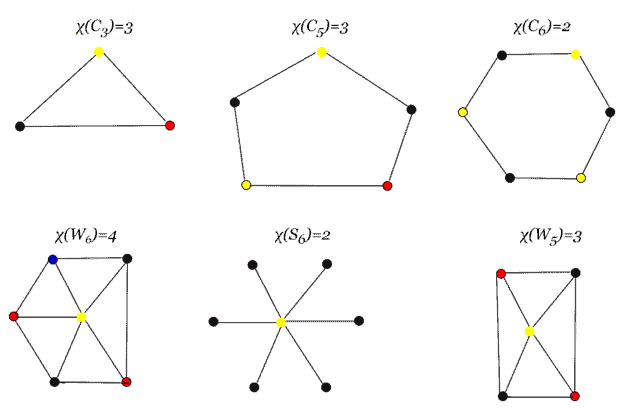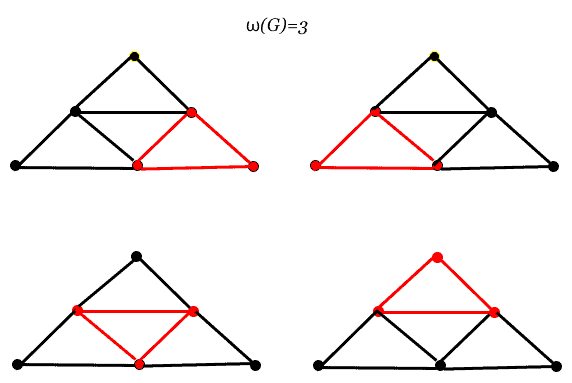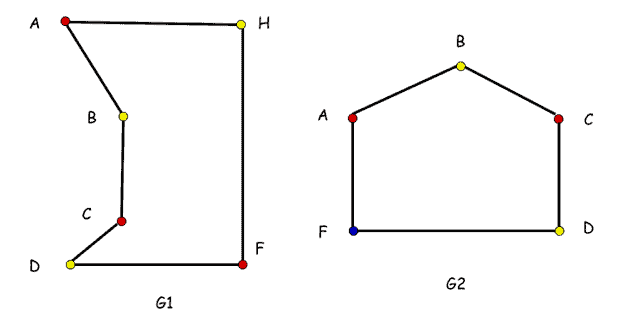1. 概述
在本教程中,我们将深入探讨完美图的定义及其定理,解析其数学意义与核心特征。接着我们会讨论完美图的实际应用场景,并介绍强完美图(Strongly Perfect)和弱完美图(Weakly Perfect)这两个用于分类完美图的概念。
2. 图论基础简介
图论是计算机科学与数学中研究图结构的基础理论。图是一种用于描述对象之间成对关系的数学结构,由节点(也称为顶点)和连接这些节点的边组成:

以上图示含义如下:
- 图 G = (V, E)
- 顶点集合 V = {A, B, C, D}
- 边集合 E = {AB, AC, BC, CD}
3. 什么是完美图?
一个图 G 是完美图,当且仅当它的每一个导出子图都满足:其团数(clique number)等于色数(chromatic number),即 ω(G) = χ(G)。反之,若不满足该条件,则称为非完美图(imperfect graph)。下面我们详细解释这两个关键概念。
3.1. 色数(Chromatic Number)
图 G 的色数是指对该图进行着色时,使得相邻节点颜色不同的前提下所需的最少颜色数。
图 G 的色数通常记作 χ(G)。
以下图示展示了几种图的最小着色方式及其对应的色数:

3.2. 团数(Clique Number)
团(clique)是指图中一个顶点集合,其中任意两个顶点之间都有边相连,即该子图是完全图。一个图 G 的团数 ω(G) 是其最大团所包含的顶点数。
换句话说:
- 团是图的一个完全子图
- 最大团指的是图中包含顶点最多的团
以下图示展示了图中团的分布以及图 G 的团数(红色数字):

3.3. 完美图的定义
对于图 G = (V, E),如果对于任意子集 S ⊆ V,其导出子图 G[S] 的团数 ω(G[S]) 与色数 χ(G[S]) 相等,则称图 G 为完美图。
换句话说,完美图的每一个导出子图都必须满足 ω = χ。
来看几个例子:

- 图 G1 中 ω(G) = 2,χ(G) = 2 ⇒ ω = χ,因此是完美图
- 图 G2 中 χ(G) = 4,ω(G) = 3 ⇒ ω ≠ χ,因此不是完美图
再来看一个具体例子:

这是一个包含 3 个顶点的环图 C3:
- 色数 χ(G) = 3
- 团数 ω(G) = 3
- A、B、C 三者构成最大团,且 ω(G) = χ(G)
因此,C3 是一个完美图 ✅
4. 强完美图(Strong Perfect Graph)
一个图是强完美图,当且仅当其每一个导出子图 H 都存在一个顶点集合,使得该集合与 H 的每一个极大团都有一个交点。
强完美图一定是完美图,但反过来不一定成立 ❗
下图展示了一个强完美图的例子:

5. 弱完美图(Weak Perfect Graph)
一个图 G 是弱完美图,当且仅当其团数 ω(G) 等于色数 χ(G)。注意,弱完美图不要求其所有导出子图都满足这个条件。
换句话说:
- 弱完美图只关心图本身是否满足 ω = χ
- 完美图则要求所有导出子图都满足 ω = χ
所以,完美图是弱完美图的子集。
下图展示了一个弱完美图的例子:

6. 总结
本文介绍了图论中一个重要而有趣的概念:完美图。我们从图论基础出发,解释了色数与团数的定义,并据此给出了完美图的正式定义。随后我们进一步介绍了强完美图与弱完美图的概念,帮助读者更全面地理解完美图的分类与特性。
完美图在组合优化、图着色、调度问题等领域有广泛应用,是理论与实践结合非常紧密的一个图论方向。掌握其基本概念,有助于在算法设计与图建模中避免“色数过高”等常见问题,是进阶图论学习的重要一步 ✅